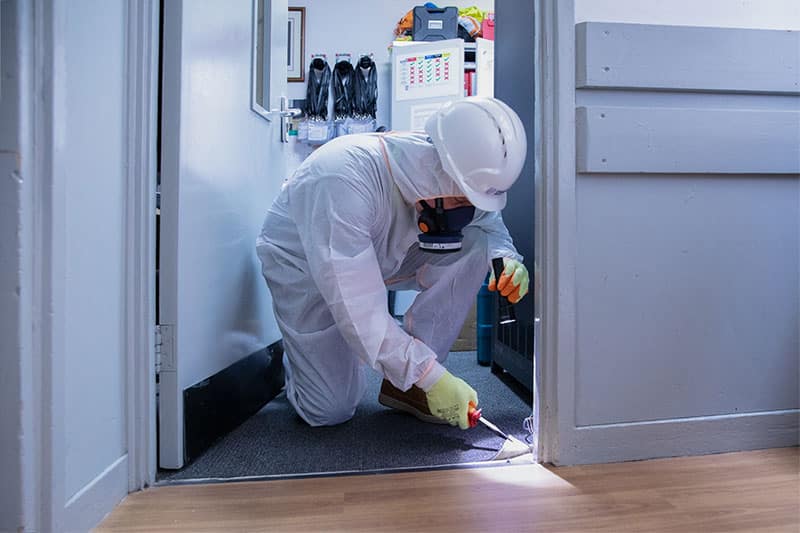What are the key tools and equipment used by asbestos surveyors for their job?
When an individual or organisation that is responsible for the maintenance and repair of a given non-domestic premises is looking to comply with their duties under asbestos-related legislation such as the Control of Asbestos Regulations 2012 (CAR 2012), arranging for an asbestos survey will be a key step.
An asbestos survey is a process by which a building, property or structure is surveyed, in order to identify asbestos-containing materials (ACMs).
The job of an asbestos surveyor, then, is a very important and specialised one, which underlines how crucial it is for them to also use the appropriate tools and equipment. Below, we have set out examples of the key tools that such professionals routinely use.

Personal protective equipment (PPE)
The importation and use of asbestos in the UK may have been banned since 1999, but the asbestos that remains in public, commercial, and residential buildings up and down the country, continues to be a very real threat to health if it is in poor condition or disturbed.
So, one of the most crucial things for asbestos surveyors to do, will be to ensure they have the necessary personal protective equipment (PPE) to hand.
Important examples of PPE and respiratory protective equipment (RPE) for asbestos surveying include a half-mask P3 respirator, gloves, protective footwear, coveralls, and – where appropriate – a hard hat, as well as ear defenders and eye protection.
Sampling equipment
The taking of samples for laboratory analysis is one of the most important aspects of asbestos surveying. So, any asbestos surveyor’s toolbox will need to include appropriate tools for safely collecting samples.
With most samples that an asbestos surveyor takes typically being collected by simply cutting a piece of material that is suspected to contain asbestos, some form of Stanley knife is one essential. Such a knife may have a fixed blade or a retractable blade, with the decision on the most suitable option coming down to the particular surveyor’s opinion or preference.
Pliers can also be invaluable for grabbing samples, as can core borers. Although the latter are expensive, they can provide a safe means of collecting samples through every layer of suspected asbestos insulation. This, in turn, helps to fulfil the surveyor’s need to take genuinely representative samples for analysis in the lab.
And of course, airtight sealable bags will also be crucial for safely containing and taking away the samples from the premises.
Fibre counters
One of the notorious aspects of asbestos, is the tendency for its individual fibres to be released and linger in the air in the event of the material being disturbed.
With these fibres being barely discernible by the human eye, and liable to move around in the air again if they are further disturbed, you can probably begin to see the vital role of asbestos air testing and monitoring at many sites.
And when it comes to such services, fibre counters are crucial for quantifying the concentration of airborne asbestos fibres. By taking samples of the air that are then analysed using a microscope, our team at Oracle Solutions can determine the level of asbestos fibres in the air at the given location, thereby helping to give assurance and peace of mind to our client.
Hand tools
I touched on the subject of Stanley or utility knives above, but they are far from the only hand tools that can be crucial to asbestos surveyors’ ability to carry out their work.
Such basic hand tools as screwdrivers, chisels, hammers, and pry bars are invaluable parts of an asbestos surveyor’s toolkit. Screwdrivers alone, for instance, help enable access to various parts of a property where maintenance people would typically require access, and where asbestos might also turn out to be present.
Moisture meters
A moisture meter is not a standard piece of equipment for the typical asbestos surveyor, although it can still be useful in certain situations related to asbestos management.
An asbestos surveyor might use a moisture meter to measure the moisture content of building materials, including those that are suspected to contain asbestos. This can be important given that if ACMs are affected by moisture, the materials could be more prone to deterioration, thereby presenting a higher risk of asbestos fibres being released.
A moisture meter can also be greatly useful for investigating areas of a building where it is suspected that water leaks or damage have occurred. Given that areas that have been affected by such problems can also pose a greater likelihood of asbestos-related issues, surveyors might prioritise such areas for attention in the event of the detection of moisture.
Digital cameras
Asbestos surveyors also routinely use digital cameras in order to document the findings of their surveys. Once the surveyor has completed the survey itself, they will typically provide the client with a full-colour report, including digital images, in order to provide complete documentation and evidence of the asbestos situation in the property.
Surveying software and devices
It is also typical for asbestos surveyors to use specialised software for the purposes of data recording and report generation. Here at Oracle Solutions, for instance, our surveyors use the industry-leading TEAMS software, which is easy to use and incorporates features ranging from a highly customisable data collection engine to a sophisticated system for generating reports.
When such software is used alongside measuring devices like laser measures and/or tape measures, asbestos surveyors can be sure of achieving the most accurate possible measurements and surveys.
Conclusion: are you on the lookout for reputable asbestos surveying services?
The above is by no means an exhaustive rundown of all forms of equipment and tools an asbestos surveyor could conceivably require and use.
With the surveyor’s basic kit also likely to include an iPad for recording findings, cleaning equipment, wipes, H type vacuums, and a set of ladders to enable access to many different areas in a building, there is a wide range of equipment that such a professional may ensure they have to hand, so that they can be confident of being prepared for a given assignment.
Whatever specific equipment a particular asbestos surveyor uses, they will want to be sure of using the most appropriate tools, so that they can be in the best possible position to carry out genuinely accurate asbestos surveys.
An asbestos surveyor’s role in ensuring safety and legal compliance on a given site could scarcely be more important, in light of the very real health risks that asbestos can present to users of a building.
If you are seeking out the most reputable such professional to carry out this kind of work on your own premises, please call us today, or send the Oracle Solutions team an email, and we will get back to you with a fast and free asbestos quote.

Written by Callum McDonald
Callum McDonald is an expert in asbestos quality management, ensuring rigorous adherence to regulations and high-quality standards in removal projects. His focus on enhancing quality and client satisfaction makes him a crucial asset in safety and compliance within the field. Callum's expertise in technical support and oversight of licensed works underscores his commitment to excellence in asbestos management, providing invaluable guidance to clients in this specialised area.
